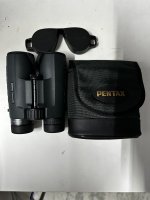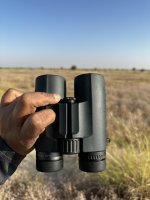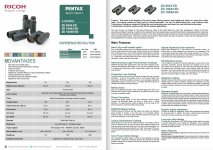At the top of Pentax’s line is the ZD ED series. These come in 10x50, 10x43 and 8X43. These are not to be confused with the slightly lesser speced ZD WP series. The ZD ED series is presented as being fully waterproof (JIS 6Class), rubber armoured, magnesium alloy body, fully multicoated with coatings to enhance transmission and dielectric coated prisms. Moreover, they have proprietary coatings that ensure water and oil/ grease do not adhere to the external glass surfaces.
I would like to thank Ricoh-Pentax India for sending over this unit. There are no strings attached and I am under no compulsion to buy it. I have been using this pair near exclusively for the last fortnight or so. I would like to share my observations.
The Bins came in a rather plain cardboard case with a shrink wrap cover. No going overboard in elaborate packaging. A good step, given environmental concerns. Inside was a synthetic case - green with faux leather 'Pentax' disc. Inside the carry case the bins fit snugly. The box bears the country of origin and it is made in Japan. A neoprene strap is included.
Covered in green armour, these are smart looking bins. The fit & finish is excellent, no loose flappy edges. The armour is grippy and does not seem to attract any extra dust. The edge of the objectives are soft as the armour extends over the barrels, giving that slightest extra cushioning. The barrels have PENTAX moulded in the rubber and it looks nice. A small plate on the left of the hinge has PENTAX Z-series ED written on it. The eyepieces have a base ring. On the left one, 8x43 ED lens is printed. The right ring is for the dioptre adjustment. It has to be pulled up. It is tight. Once set, the ring is to be pushed down. It has stayed in place, so full marks there. The strap attachment lugs are placed on either side and appear ok for any harness/ strap.

At 715 gms, these are in weight class that is the norm for premium bins but look smaller than I expected. The design is a single hinge type – a large hinge on which the two barrels move. The inter-pupillary distance is between 58.4mm to 74.2mm – generous enough. It is tight and moves securely. The construction quality is good enough so by all indications it won’t become loose, anytime soon. The focusing ring is ribbed and huge. The right index finger comes on it as I raise it to my eyes. It is smooth and very precise but not the fastest.
The objective covers are rubber and fit inside the barrels. They are tethered to the knob that covers the tripod mount. Nice arrangement. The rain guard is plastic and loose – which suits me fine – quick to put on and take off.
I took this pair with me on my recent travel to the western desert. No better place than the dusty desert to field-test a pair. As I have already said it held up well to the dust and grime, and armour looked clean after 15 days of regular use.
The specs if you have noticed, are a bit unusual. We get binoculars with objective size, 20mm, 25mm, 30mm, 40mm, 50mm and so on. We also get binoculars with objectives 32mm and 42mm. Here we have 43mm. Does one millimetre make a difference? Well it probably does by allowing a slightly more amount of light to enter the barrel. I however could not make out the difference, even when I compared it with other binoculars I had. It is brighter in low light than the CL 8x30B but then 30mm vs 43 mm is not a fair comparison. It is brighter by a lot than some entry level 8x42s but it is also much more expensive.
The objective lenses have a green hue. Just a touch (the Swarovskis appear a bit more tobacco hued green while the Zeiss’ are pink). The barrels are ridged and baffled all the way and no shiny internals can be seen. The barrels are very clean inside – hinting at good quality control. All efforts have been made to cut down stray reflections and ghosting.
The eyepieces are metal and twist out. There are four stops in all. That should cover most face types.
Asahi Pentax gave the world the first multicoated optics and that is a traditional strength the brand Pentax still carries. The lenses and prisms are designed and coated to have high transmission. The view is outright bright, sharp and contrasty. The beautifully camouflaged mother GIB popped into focus with the catchlight distinct from over 100 meters away. A Long-legged Buzzard on a pole looked gorgeous – as if it just had a beauty makeover in a salon. It just blew away an Olympus DP Porro, an old Pentax DCF Porro, a Bushnell H2O roof and a Nikon Prostaff by its clarity. The sweet spot is large, most of the field is in focus (and I could see the entire field comfortably with spectacles on thanks to the massive 22mm eye relief. Blurring is just at the very edge and most of it could be focused away. Astigmatism is low. Chromatic aberration aka purple fringing is negligible in the centre but moderate at the edges – northing to spoil that lovely view. The brightness is good as a Zeiss Conquest HD – hinting to a very high transmission in the visible spectrum. I noticed no colour cast. The minimum focusing distance is stated to be 2 mts. My guess is it is slightly less than that. The spec sheet is conservative. The view is punchy, sharp and it handles sunlight incident on the objectives from the side quite well.

So why is this not popular enough? Richoh-Pentax’s marketing philosophy is a bit strange. Difficult to see them advertise anywhere. This is a well-made pair with good innards. Maybe not Schott glass, but Hoya and others make great glass in Japan. The spec sheet says Bak-4 prisms and the view supports that.
Oh yes, the field. At 6.3 degrees, 110 meters at 1000 meters, it is certainly not wide field, especially when compared to the offerings from other premium manufacturers. This is a 8x43 with field of my Zeiss FL 10X42. Go figure. Except in a select few models, wide fields come with limitations such as smallish sweet spots, excessive astigmatism and blurring at the edge. The trick lies in eye-piece design. Here the Pentax engineers have taken a different approach. They knew the field is not 150 mts at 1000 meters (as in a Zeiss SF or Swaro NL Pure - but neither is this that expensive). So they made sure they had a field that was as well corrected as possible. Minimal aberrations and sharp edge to edge. I could follow Harriers and Sandgrouse in flight in the evening with this pair and the field looked every bit good as my Zeiss FL 10X42s (which are bench markedly good). In the fading light a lone Indian Fox came looking for leftovers. His black tail-tip was distinct. The night sky above the Thar desert looks magnificent with the naked eye. With these binoculars, Capella looked bright as it should be and Andromeda, Cassiopeia and Perseus were breathtaking. Early in the morning, Ursa Major was bright and distinct. A lovely red sliver of moon rose late – red because of dust in the horizon. I really should look at the night sky more. back home this pair helped in adding a new species to the Campus check-list - a Green warbler. I can bird with this quite well - and for this statement I might get bashed. All in all, I won’t hesitate to recommend these binoculars to anyone. If looked after, these will last and give years of enjoyment.
I love a wide field as any other person. Hence the wish that Pentax updated these with a wider field. It need not be 150 meters. A 130-140 metre field will make these far superior and a serious contender for a sub-alpha spot. But will that compromise the eye-relief? Well I am not an engineer.
Arijit
I would like to thank Ricoh-Pentax India for sending over this unit. There are no strings attached and I am under no compulsion to buy it. I have been using this pair near exclusively for the last fortnight or so. I would like to share my observations.
The Bins came in a rather plain cardboard case with a shrink wrap cover. No going overboard in elaborate packaging. A good step, given environmental concerns. Inside was a synthetic case - green with faux leather 'Pentax' disc. Inside the carry case the bins fit snugly. The box bears the country of origin and it is made in Japan. A neoprene strap is included.
Covered in green armour, these are smart looking bins. The fit & finish is excellent, no loose flappy edges. The armour is grippy and does not seem to attract any extra dust. The edge of the objectives are soft as the armour extends over the barrels, giving that slightest extra cushioning. The barrels have PENTAX moulded in the rubber and it looks nice. A small plate on the left of the hinge has PENTAX Z-series ED written on it. The eyepieces have a base ring. On the left one, 8x43 ED lens is printed. The right ring is for the dioptre adjustment. It has to be pulled up. It is tight. Once set, the ring is to be pushed down. It has stayed in place, so full marks there. The strap attachment lugs are placed on either side and appear ok for any harness/ strap.

At 715 gms, these are in weight class that is the norm for premium bins but look smaller than I expected. The design is a single hinge type – a large hinge on which the two barrels move. The inter-pupillary distance is between 58.4mm to 74.2mm – generous enough. It is tight and moves securely. The construction quality is good enough so by all indications it won’t become loose, anytime soon. The focusing ring is ribbed and huge. The right index finger comes on it as I raise it to my eyes. It is smooth and very precise but not the fastest.
The objective covers are rubber and fit inside the barrels. They are tethered to the knob that covers the tripod mount. Nice arrangement. The rain guard is plastic and loose – which suits me fine – quick to put on and take off.
I took this pair with me on my recent travel to the western desert. No better place than the dusty desert to field-test a pair. As I have already said it held up well to the dust and grime, and armour looked clean after 15 days of regular use.
The specs if you have noticed, are a bit unusual. We get binoculars with objective size, 20mm, 25mm, 30mm, 40mm, 50mm and so on. We also get binoculars with objectives 32mm and 42mm. Here we have 43mm. Does one millimetre make a difference? Well it probably does by allowing a slightly more amount of light to enter the barrel. I however could not make out the difference, even when I compared it with other binoculars I had. It is brighter in low light than the CL 8x30B but then 30mm vs 43 mm is not a fair comparison. It is brighter by a lot than some entry level 8x42s but it is also much more expensive.
The objective lenses have a green hue. Just a touch (the Swarovskis appear a bit more tobacco hued green while the Zeiss’ are pink). The barrels are ridged and baffled all the way and no shiny internals can be seen. The barrels are very clean inside – hinting at good quality control. All efforts have been made to cut down stray reflections and ghosting.
The eyepieces are metal and twist out. There are four stops in all. That should cover most face types.
Asahi Pentax gave the world the first multicoated optics and that is a traditional strength the brand Pentax still carries. The lenses and prisms are designed and coated to have high transmission. The view is outright bright, sharp and contrasty. The beautifully camouflaged mother GIB popped into focus with the catchlight distinct from over 100 meters away. A Long-legged Buzzard on a pole looked gorgeous – as if it just had a beauty makeover in a salon. It just blew away an Olympus DP Porro, an old Pentax DCF Porro, a Bushnell H2O roof and a Nikon Prostaff by its clarity. The sweet spot is large, most of the field is in focus (and I could see the entire field comfortably with spectacles on thanks to the massive 22mm eye relief. Blurring is just at the very edge and most of it could be focused away. Astigmatism is low. Chromatic aberration aka purple fringing is negligible in the centre but moderate at the edges – northing to spoil that lovely view. The brightness is good as a Zeiss Conquest HD – hinting to a very high transmission in the visible spectrum. I noticed no colour cast. The minimum focusing distance is stated to be 2 mts. My guess is it is slightly less than that. The spec sheet is conservative. The view is punchy, sharp and it handles sunlight incident on the objectives from the side quite well.

So why is this not popular enough? Richoh-Pentax’s marketing philosophy is a bit strange. Difficult to see them advertise anywhere. This is a well-made pair with good innards. Maybe not Schott glass, but Hoya and others make great glass in Japan. The spec sheet says Bak-4 prisms and the view supports that.
Oh yes, the field. At 6.3 degrees, 110 meters at 1000 meters, it is certainly not wide field, especially when compared to the offerings from other premium manufacturers. This is a 8x43 with field of my Zeiss FL 10X42. Go figure. Except in a select few models, wide fields come with limitations such as smallish sweet spots, excessive astigmatism and blurring at the edge. The trick lies in eye-piece design. Here the Pentax engineers have taken a different approach. They knew the field is not 150 mts at 1000 meters (as in a Zeiss SF or Swaro NL Pure - but neither is this that expensive). So they made sure they had a field that was as well corrected as possible. Minimal aberrations and sharp edge to edge. I could follow Harriers and Sandgrouse in flight in the evening with this pair and the field looked every bit good as my Zeiss FL 10X42s (which are bench markedly good). In the fading light a lone Indian Fox came looking for leftovers. His black tail-tip was distinct. The night sky above the Thar desert looks magnificent with the naked eye. With these binoculars, Capella looked bright as it should be and Andromeda, Cassiopeia and Perseus were breathtaking. Early in the morning, Ursa Major was bright and distinct. A lovely red sliver of moon rose late – red because of dust in the horizon. I really should look at the night sky more. back home this pair helped in adding a new species to the Campus check-list - a Green warbler. I can bird with this quite well - and for this statement I might get bashed. All in all, I won’t hesitate to recommend these binoculars to anyone. If looked after, these will last and give years of enjoyment.
I love a wide field as any other person. Hence the wish that Pentax updated these with a wider field. It need not be 150 meters. A 130-140 metre field will make these far superior and a serious contender for a sub-alpha spot. But will that compromise the eye-relief? Well I am not an engineer.
Arijit






